The performance and physical properties of polymers are mainly dependent on the characteristics of polymer molecules themselves. The behavior of the materials is influenced by the molecular weight and molecular weight distribution, molecular size and structure.
Better knowledge on, and control of, these properties enables polymer manufacturers to manage the production and quality of their polymers. Precise measurement of the molecular weight of a polymer is historically based on the standards of the same polymer. However, with the development of advanced detection technologies like intrinsic viscosity and light scattering, it is possible to perform absolute measurements.
Gel-permeation, or size-exclusion, chromatography (GPC/SEC) is one of the most widely used methods to investigate these parameters. It involves separating the sample as it passes through a porous yet inert column matrix.
The smaller molecules penetrate deep inside the pores, while the larger molecules are separated, and hence, move along the column rapidly. Therefore, the separation is dependent on hydrodynamic volume. However, the main objective is often to investigate the molecular weight of the sample.
The OMNISEC system from Malvern Panalytical is an entirely new multi-detector GPC system combined with intrinsic viscosity (IV), ultraviolet (UV), refractive index (RI) and light scattering detectors, which help obtain more information about a sample concurrently.
The new design of the instrument makes it suitable for performing measurements with less of the sample and lower molecular weights. This article describes the use of the OMNISEC system (Figure 1) to measure the size, molecular weight distribution and molecular weight of three common polymers.
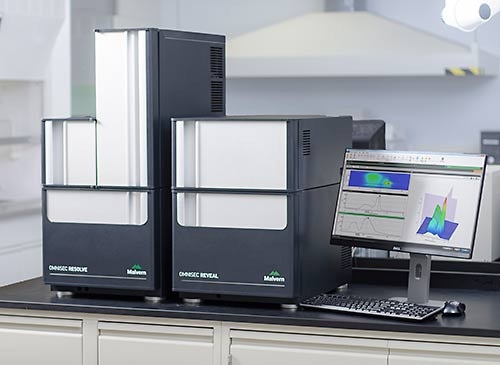
Figure 1. The OMNISEC system.
Materials and Methods
In the OMNISEC system, two Viscotek T6000M columns were used to separate the samples. Using 300 ppm BHT, the mobile phase was THF stabilized. In order to ensure complete dissolution, the samples were allowed to dissolve throughout the night. The detectors and columns were maintained at 35 °C to provide maximum baseline stability and good separation.
Samples of polyvinylchloride (PVC), broad distribution polymethylmethacrylate (PMMA), and broad distribution polystyrene (PS) were investigated in this experiment. All the samples were allowed to dissolve in the mobile phase and run through the system. The new OMNISEC system was used to measure their molecular weights.
Results
Figure 2A shows a chromatogram of the polystyrene sample with high polydispersity. From the table shown in Figure 2B, the value of molecular weight measured using the light scattering detector was found to be 249.7 kDa. Figure 2C shows the RI chromatogram overlaid with the molecular weight distribution. Figure 2D shows the overlaid replicate injections of the molecular weight distribution for the polystyrene sample, which suggest excellent reproducibility of the light scattering data.
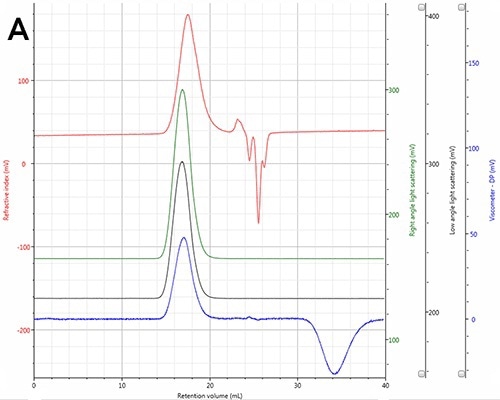
(B)
| Parameter |
Polystyrene |
| Mn (Da) |
108,900 |
| Mw (Da) |
249,770 |
| PD (Mw/Mn) |
2.294 |
| Intrinsic viscosity (dL/g) |
0.814 |
| Rhw (nm) |
13.902 |
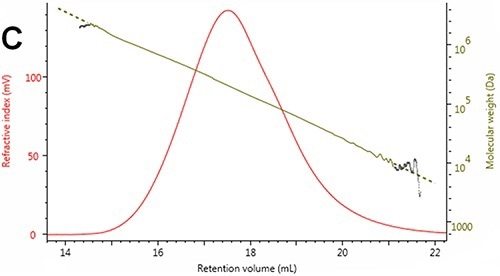
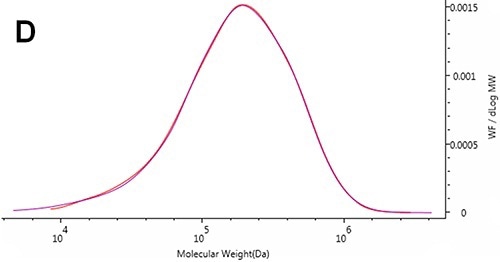
Figure 2. (A) Chromatogram of the polystyrene sample showing the RI (red), Viscometer (blue) RALS (green) and LALS (black) detector signals. (B) Measured molecular weight, polydispersity and intrinsic viscosity. (C) RI chromatogram of the polystyrene sample overlaid with the molecular weight distribution (black). (D) Overlaid replicate injections of molecular weight distribution.
A PMMA sample was allowed to dissolve in the mobile phase and separated on the system. The chromatogram of the sample is shown in Figure 3, and the results of the molecular weight of the sample are summarized in Table 1. The absolute molecular weight of the sample measured using the OMNISEC system was found to be 89.4 kDa.
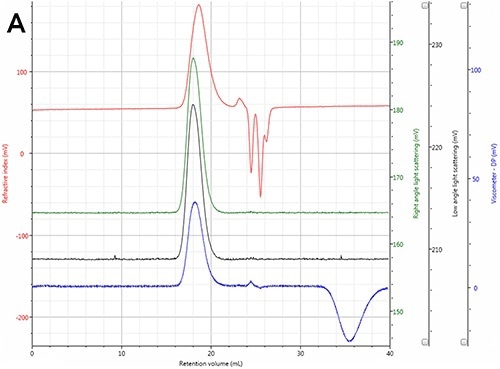
Figure 3. Chromatogram of a broad PMMA showing the RI (red), Viscometer (blue) RALS (green) and LALS (black) detector signals.
Table 1. Measured molecular weight, polydispersity and intrinsic viscosity of PMMA sample.
| Parameter |
Polymethylmethacrylate |
| Mn (Da) |
431,670 |
| Mw (Da) |
894,430 |
| PD (Mw/Mn) |
2.072 |
| Intrinsic viscosity (dL/g) |
0.361 |
| Rhw (nm) |
7.647 |
A PVC sample was dissolved in the mobile phase, and subsequently separated on the system. Its chromatogram is shown in Figure 4, and molecular weight results are shown in Table 2. From the results, the absolute molecular weight of the sample was found to be 227 kDa.
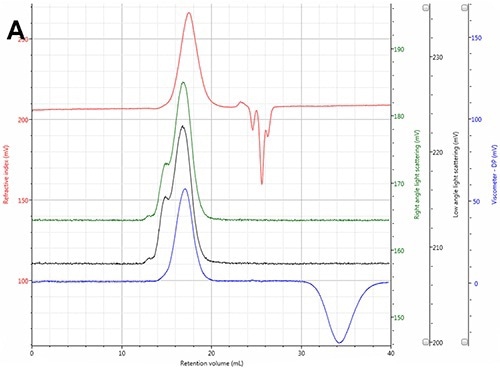
Figure 4. Chromatogram of polyvinylchloride (PVC) showing the RI (red), Viscometer (blue) RALS (green) and LALS (black) detector signals.
Table 2. Measured molecular weight, polydispersity and intrinsic viscosity of PVC sample.
| Parameter |
PVC |
| Mn (Da) |
112,240 |
| Mw (Da) |
227,090 |
| PD (Mw/Mn) |
2.023 |
| Intrinsic viscosity (dL/g) |
1.353 |
| Rhw (nm) |
15.530 |
The molecular weight distribution overlay of PVC (blue and tan), PMMA (green & black) and PS (red & purple) is shown in Figure 5. It has to be noted that the plot in this graph shows the weight fraction against molecular weight, and an increase in the molecular weight from left to right on the x-axis. As evident from the polydispersity value (Mw/Mn), the peaks are polydisperse, representing a broad range of molecular weights within these peaks.
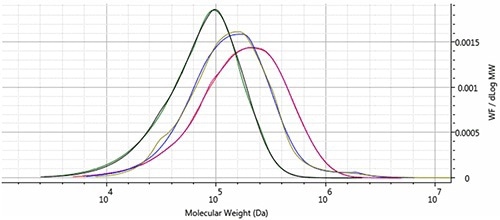
Figure 5. Molecular weight distribution overlays of PS (red & purple), PMMA (green & black), and PVC (blue and tan).
Conclusion
Using PS, PMMA and PVC samples, the application of OMNISEC to precisely measure the absolute molecular weight of any polymers irrespective of elution volume or structure has been demonstrated. Although simple polymers were used for demonstration here, the method is suitable for any type of polymer that can be measured using the GPC/SEC.
It is impossible for the traditional chromatography systems, calibrated with molecular weight standards, to precisely measure the molecular weights of these samples unless their calibration was carried out with the respective molecular weight standards for each sample. This can be achieved in general polymers like PMMA or PS, with the availability of narrow standards kits.
However, this cannot be achieved in even slightly exotic polymers or novel polymers at the time of research or development. The measurement of accurate molecular weights can be performed using a light scattering based system like OMNISEC.
The availability of accurate information enables the polymer manufacturers to effectively regulate the research, development and manufacturing process of the desired polymers. This facilitates generation of higher quality product, improved grading, and minimization of production-related quality issues. These improvements can eventually optimize product performance and increase the competitiveness of the company.

This information has been sourced, reviewed and adapted from materials provided by Malvern Panalytical.
For more information on this source, please visit Malvern Panalytical.